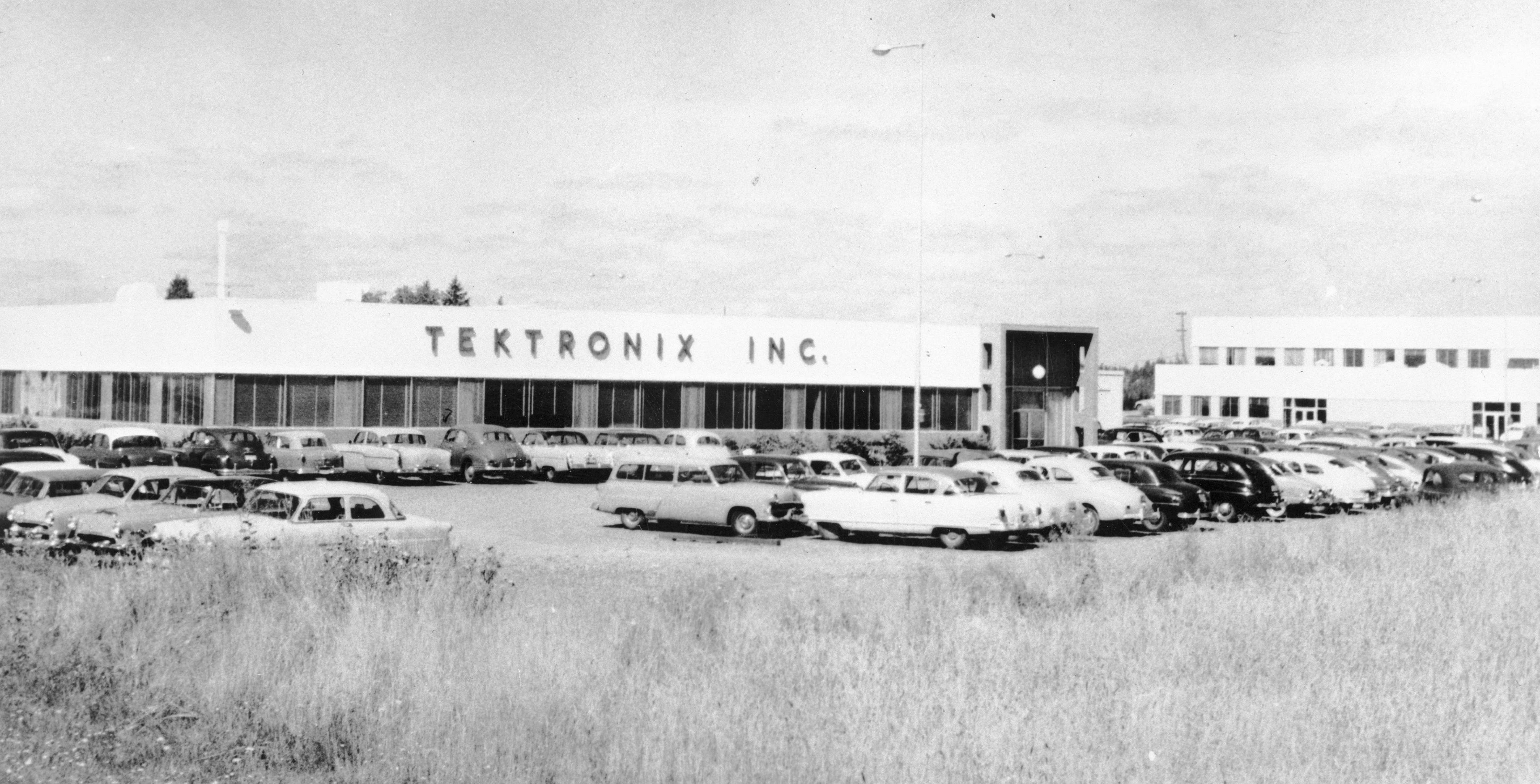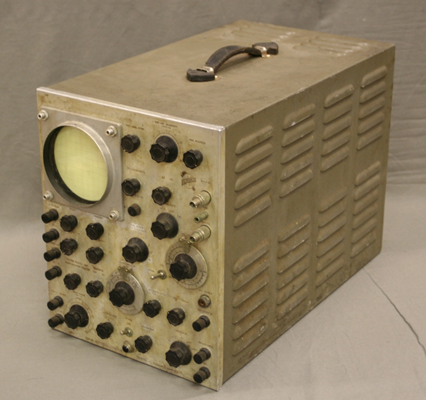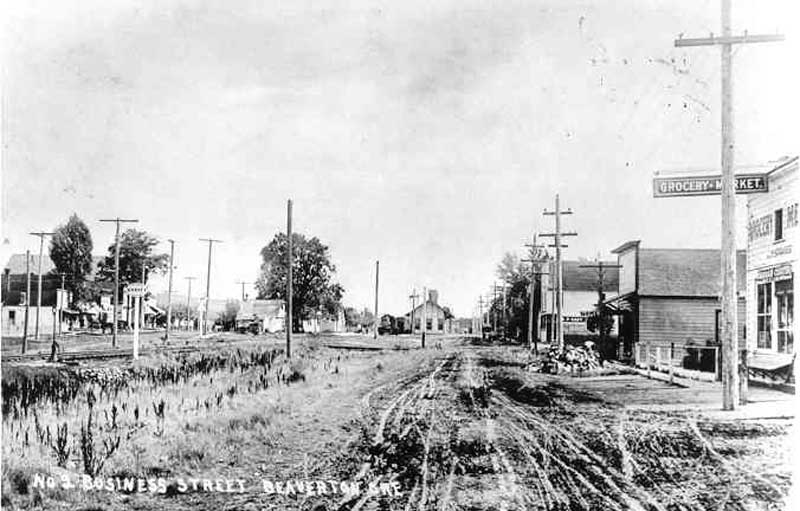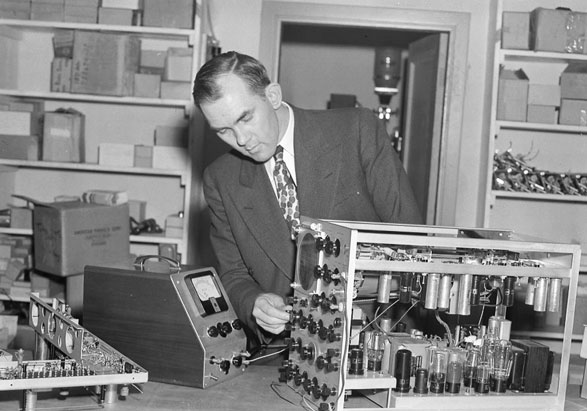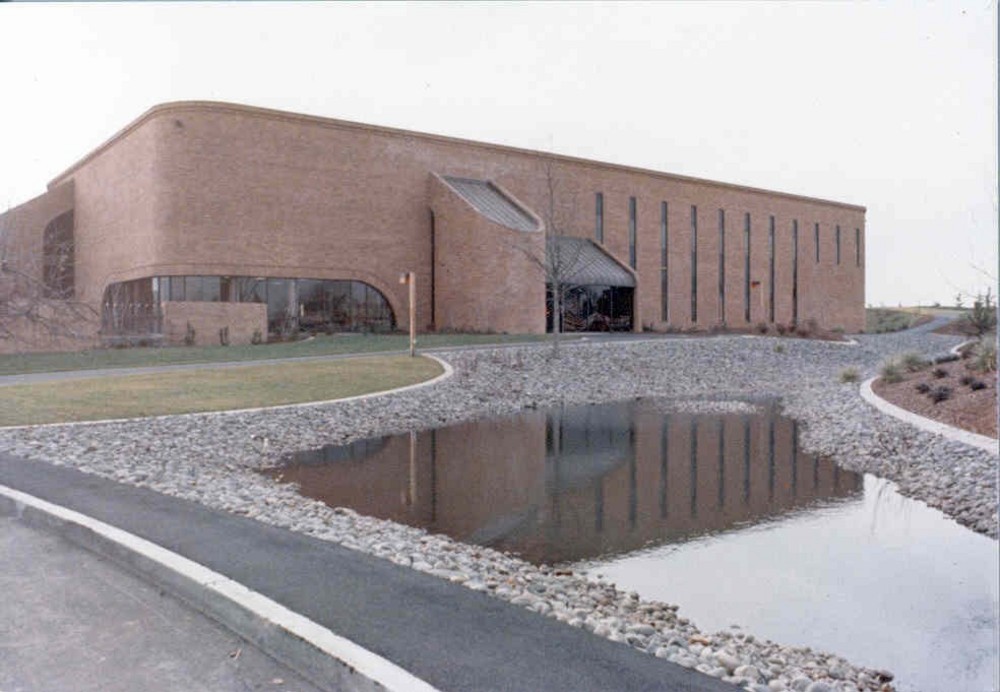Tektronix, one of Oregon's most prominent and innovative high-technology companies, was founded in 1946 and quickly grew into the world's leading manufacturer of specialized test and measurement instruments. Tektronix is widely credited with commercializing the first oscilloscope that incorporated the "triggered sweep circuit," which allowed users to pick up and display high-speed electronic events without delays or interruptions.
The success of Tektronix profoundly influenced the growth of Portland's high-technology industry, which became known as the Silicon Forest. Talented workers were attracted to the region, and the innovations created at Tektronix seeded the growth of many spin-off firms.
In 1946, Jack Murdock, Howard Vollum, Miles Tippery, and Glenn McDowell formed Tekrad. They set up their firm in the basement of Murdock's house on Southeast Foster Road in Portland. A year later, they moved to a new location on Southeast Seventh and Hawthorne, where they operated Hawthorne Electronics, a radio retail and service business.
Vollum, with a physics degree from Reed College in 1936, had run his own radio repair shop before he was drafted into the army and joined the Signal Corps. He was assigned to the Corps’ Electronics Training Group in Belmar, New Jersey, where he had gained expertise in the development of radar. Instead of going to college, Murdock opened Murdock Radio and Appliance and served in the Coast Guard, where he maintained and repaired radio equipment.
Working with wartime surplus parts, Vollum and his colleagues developed their first commercially successful oscilloscope, the 511, which went into production in 1947. The instrument was small and portable, enclosed in a well-designed metal case, and capable of making accurate measurements because of its triggered sweep circuit.
Throughout the next decades, Tektronix set standards for test and measurement instruments. Net sales rose from $1.2 million in 1950 to more than $31 million in 1959, and Tektronix became one of the largest employers in the Portland metropolitan area. Employment grew from 16 in 1947 to 3,515 in 1960. During the early 1980s, employment peaked at 24,028 worldwide, with 15,000 employees in the Portland area.
Tektronix attracted talented people from across the country. Employees valued Tektronix's informal egalitarian culture and its investment in professional development and education. In the 1950s, the offerings of the Tektronix Education Program rivaled those at local community colleges and universities, and Tektronix was often referred to as the "University of Tektronix."
Tektronix's commercial success and market leadership allowed the firm to invest heavily in research and development. In 1972, Tek Labs was established as an in-house research and development organization to conduct research in areas as diverse as integrated circuits, solid-state devices, cathode ray tubes, and software programming. Numerous Ph.D.-level researchers were allowed to freely experiment and contribute to the knowledge base of the emerging electronics industry. Several technologies developed at Tek Labs built the foundation for numerous spin-off firms that still operate in the Silicon Forest. For example, TriQuint Semiconductors commercialized research on gallium arsenide semiconductors, and technological advances in color projectors were commercialized through the startup Planar Systems.
Tektronix evolved as a vertically integrated company with diverse in-house manufacturing, research, and development competencies. These organizational developments were later criticized by new management for being inefficient, and the company underwent major corporate restructuring as it faced increased competition.
The company's visionary founder, Jack Murdock, died in a plane accident in 1971. Under new leadership, Tektronix began to reorganize. After years of product diversification in such areas as printers and printed circuit-board manufacturing, corporate management refocused on the oscilloscope. Tek Labs was eliminated, and business units that were deemed not critical to the firm's core mission were divested. Tektronix also significantly reduced its local employment.
From the mid-1940s to the late 1970s, Tektronix employees founded about a dozen companies, including Floating Point Systems, Chemtrix, Rogers Organs, Exact Electronics, and Analog Devices. Some of these companies became important incubators for subsequent spin-offs, as forty-eight companies spun off from Tektronix between 1980 and 2000. Corporate restructuring, employee frustration, divestitures, and the establishment of an internal venture capital firm known as the Tektronix Development Corporation, which funded new startups, contributed to a boom in local entrepreneurship.
Tektronix also influenced local politics, education, and philanthropy. Through the Tektronix Foundation, the firm has played an important role as a philanthropist and supporter of social and environmental causes.
In 2007, the Danaher Corporation acquired Tektronix for $2.85 billion. Today, Tektronix, now located in Beaverton, operates as a wholly owned subsidiary. Since the acquisition, Danaher has cut Tektronix's worldwide employment by about 10 percent; in 2007, local employment stood at about 2,100.
-
![Tektronix, Inc.]()
Tektronix, exterior, OrHi 76876.
Tektronix, Inc. Oreg. Hist. Soc. Research Lib., OrHi 76876
-
![Tecktronix 7834 Storage Oscilloscope, circa 1980.]()
Tektronix oscilloscope, OrHi 105881.
Tecktronix 7834 Storage Oscilloscope, circa 1980. Oreg. Hist. Soc. Research Lib., OrHi 105881
-
![]()
Tektronix test prototype oscilloscope, c.1955.
Oregon Historical Society Museum Collection, 99-67.1
Related Entries
-
![Beaverton]()
Beaverton
Beaverton is the seventh largest city in Oregon and the second largest …
-
![Howard Vollum (1913–1986)]()
Howard Vollum (1913–1986)
Howard Vollum was a founding partner of Tektronix, an innovative electr…
-
![Intel]()
Intel
Intel Corporation, the world's leading manufacturer of semiconductors (…
-
Silicon Forest
The Silicon Forest is the name applied to the cluster of high-technolog…
Related Historical Records
Map This on the Oregon History WayFinder
The Oregon History Wayfinder is an interactive map that identifies significant places, people, and events in Oregon history.
Further Reading
Dodds, G.B. and C.E. Wollner. The Silicon Forest: High tech in the Portland Area. Portland: Oregon Historical Society Press, 1990.
Lee, M.M. Winning with People: The First 40 Years of Tektronix. Portland, Oreg.: Tektronix, 1986.
Mayer, H. "Planting High Technology Seeds: Tektronix' Role in the Creation of Portland's Silicon Forest." Oregon Historical Quarterly 106:4 (2005), 568-593.

